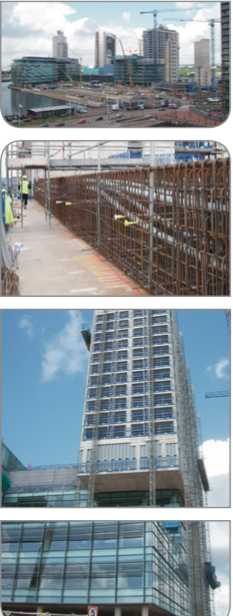 Post-Tensioned Building
Post-Tensioned Building
Client
Peel Media
Management Control
Bovis Lend Lease
Frame Contractor
Heyrod
Structural Engineer
Jacobs & Halcrow Yolles
Works Commence
November 2007
Works Completed
March 2010
The Media City UK development includes offices, studios, retail space, 378 apartments, a 2200 space multi-storey car park, two hotels and a public piazza. Heyrod Construction was the frame contractor for the four concrete buildings. Freyssinet was appointed to do all the post-tensioning. The first building to start, late in 2007, was seven storey Block C. Eight storey Block A was next in February 2008, to be followed a couple of months later by the 21 levels of Block B. All three were to be used by the BBC as production and office space. Block B4, a new higher education campus for the University of Salford was built to house 700 students and staff within its 13 floors.
All four buildings are notable post-tensioned structures in their own right, but together the area of PT floor slab totals 80,500m2 making Media City UK one of the most significant PT office developments in the UK. The basic structural form for all the buildings is a 275mm thick PT flat slab on a 9x9m grid. Depths increase to 300mm and 400mm to cater for locally increased spans of 12 and 12.8m ,respectively.
Block B is duel use, being offices for the BBC at the lower levels and apartments from level six to 21. On the east wing, the apartment block footprint needed to be significantly larger than the office below so three 1.75m deep by 2m wide beams cantilevered 8.25m from the front of the building to create a dramatic feature visible from the public piazza below. Each beam contained ten 19-strand tendons, which gave a total prestressing force of 42,000kN per beam to resist the 56,000kNm ULS bending moment. The 28 day concrete strength was 60N/mm2.
Post-tensioning is an excellent way of forming cantilevers. Not only do the tendons deliver the required strength, they also provide an upward deflection due to the tendon profile. This physically lifts the tip of the cantilever and the designer can play with the post-tensioning force and tendon profile to tune the uplift to match the downward deflection from the structure above. Thus, deflection control is mastered.
